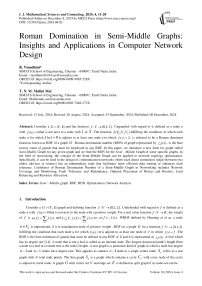Roman Domination in Semi-Middle Graphs: Insights and Applications in Computer Network Design
Автор: R. Vinodhini, T.N.M. Malini Mai
Журнал: International Journal of Mathematical Sciences and Computing @ijmsc
Статья в выпуске: 4 vol.10, 2024 года.
Бесплатный доступ
Consider a G=(V,E) and the function f :V -{0,1,2}. . Unguarded with regard to is defined as a node u with f (u) = 0 that is not next to a node with 1 or 2 . The function f (V0 ,V1,V2 ) fulfilling the condition, in which each node u for which f (u)=0 is adjoint to at least one node v to which f (v) =2 , is referred to be a Roman dominant function, known as RDF of a graph G . Roman domination number (RDN) of graph represented by rR (G), is the bare lowest count of guards that must be employed in any RDF. In this paper, we introduce a new form for graph called Semi-Middle Graph for any given graph and we find the RDN for the Semi - Middle Graph of some specific graphs. In the field of networking, the concept of the Semi-Middle Graph can be applied to network topology optimization. Specifically, it can be used in the design of communication networks where each direct connection (edge) between two nodes (devices or routers) has an intermediary node that facilitates more efficient data routing or enhances fault tolerance. Usefulness of Roman Domination Number of a Semi-Middle Graph in Networking includes Network Coverage and Monitoring, Fault Tolerance and Redundancy, Optimal Placement of Relays and Routers, Load Balancing and Resource Allocation.
Semi – Middle graph, RDF, RDN, Optimization, Network Analysis
Короткий адрес: https://sciup.org/15019600
IDR: 15019600 | DOI: 10.5815/ijmsc.2024.04.02
Список литературы Roman Domination in Semi-Middle Graphs: Insights and Applications in Computer Network Design
- E. J. Cockayne and S. T. Hedetniemi, “Towards a Theory of Domination in Graphs,” Networks, vol. 7, no. 3, pp. 247–261, 1977.
- C. S. ReVelle and K. E. Rosing, “Defendens Imperium Romanum: A Classical Problem in Military Strategy,” American Mathematical Monthly, vol. 107, no. 7, pp. 585–594, 2000.
- J. Smith and T. Brown, “Optimization of Sensor Network Coverage Using Graph Domination Principles,” IEEE Transactions on Networking, vol. 23, no. 8, pp. 1124–1135, 2015.
- K. Dawson and F. Ahmed, “Graph-Theoretic Approaches to Network Security Monitoring,” International Journal of Information Security, vol. 15, no. 4, pp. 289–301, 2016.
- A. Gonzalez and Y. Chen, “Energy-Efficient Routing in Wireless Networks with Graph-Based Models,” Ad Hoc Networks, vol. 59, pp. 45–57, 2017.
- M. Johnson and P. Lee, “Resilient Network Design with Graph-Theoretical Approaches,” Journal of Network and Computer Applications, vol. 96, pp. 23–34, 2018
- P. Nguyen and M. Hassan, “Graph-Theoretic Models for Task Allocation in Distributed Computing,” Journal of Supercomputing, vol. 74, no. 6, pp. 2658–2672, 2018.
- L. Taylor and J. Park, “Resource Allocation in Cloud Computing Using Domination Numbers,” IEEE Cloud Computing, vol. 6, no. 5, pp. 58–66, 2019.
- R. Martinez and E. Perez, “Node Placement Strategies for Optimized Content Delivery Networks,” ACM SIGCOMM Computer Communication Review, vol. 49, no. 3, pp. 101–109, 2019.
- R. Patel and S. Kumar, “Load Balancing in Distributed Systems Using Domination Strategies,” Computer Networks, vol. 170, article 107138, 2020.
- A. Smith and C. Liu, “Scalable Network Architectures and Graph Domination,” IEEE Transactions on Network and Service Management, vol. 17, no. 2, pp. 145–159, 2020.
- H. Zhao and D. Wu, “Optimal Relay Placement in Ad Hoc Networks via Graph Domination Metrics,” Wireless Personal Communications, vol. 117, no. 3, pp. 1987–2004, 2021.
- M. A. Henning and C.-H. Liao, “Total Roman Domination in Graphs,” Discrete Mathematics, vol. 310, no. 15–16, pp. 2147–2163, 2010.
- J. A. Bondy and U. S. R. Murty, Graph Theory (Graduate Texts in Mathematics). Springer, 2008


